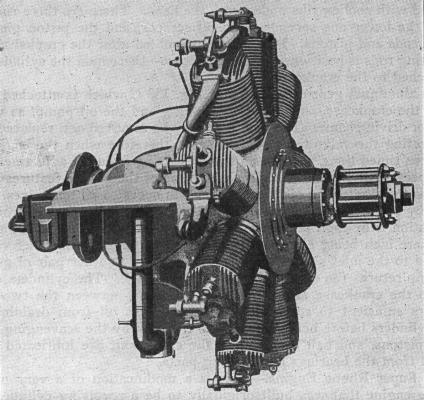| Super Rhone Engine |

| ||
|---|---|---|---|
| |
| ||
 |
|||
|
The Super Rhone Radial Air-Cooled Engine.
| |||
| The Super Rhone was a unsuccessful radial engine conversion, of the very popular 80 hp Le Rhone rotary engine. As the demand for greater power and engine sizes became required, rotary engine gyroscopic forces were becoming unmanageable. However, these forces had their useful features—if the pilot could master them. It provided the Sopwith Camel with remarkable turning power, but the engine also delivered sharp torque reversals when the ignition was cut, which put excessive stress on the engine mounts and the airframe. | |||
| A special conversion was designed and patents applied for by Charles E. Quick, and the modified engine was produced by the Quick Air Motors of Wichita, Kansas, who purchased wartime surplus engines from the Government.1 The original Le Rhone rotary engine, which provided the basis for the conversion to the Super Rhone, was used by France and England in very large quantities and with excellent results. | |||
|
Converting the engine to a fixed radial type had resulted in a marked decrease in fuel and oil consumption, with a resulting increase in power output, because the engine would run faster with fixed cylinders, and the horsepower formerly used in turning the cylinders through the air was now delivered to the crankshaft. Most of the American pursuit pilots who were instructed at the Third Aviation Instruction Center of the A.E.F. at Issoudoun, Indre, France received their preliminary training on airplanes equipped with the Le Rhone engine.
The cylinders were of steel with circumferential flanges, turned on the barrel and longitudinal flanges milled in the heads. In the rotary form, the gasoline was admitted through a hollow crankshaft, and castor oil was necessary for engine lubrication, and large quantities of oil were thrown out of the exhaust ports as the cylinder assembly revolved. This made flying behind a rotary engine exceptionally dirty for the pilot, which was true of other rotary types such as the Gnome and Clerget. Cowling interfered with engine cooling, so pilots trained on rotary engines knew the taste and smell of partially burned castor oil very well. The pilot would be soaking up oil at a fairly rapid rate and was prone to its purgative qualities, but fortunately for the pilot, this was eliminated on the Super Rhone. From the nature of its construction, with its taper jointed counterbalanced crankshaft of single throw, complete disassembly could be accomplished by a mechanic of ordinary ability in thirty minutes time, which reduced lost flying time in schedule service. The saving in weight through the elimination of the radiator and the water piping and connections, as well as the water itself, permitting a greater pay-load than with a water-cooled engine, and at the same time, it removed a cause of frequent trouble with consequent forced landings. The absence of the radiator reduced wind resistance, giving greater speed and maneuverability, and again reducing cost. In the Super Rhone engine, any complications in effective air-cooling was entirely overcome by a simple process which admitted fresh air, under atmospheric pressure to the crankcase, which forced a complete change of air within the crankcase with each revolution. Thus, excessive accumulation of heat at the center was eliminated by the free passage of fresh cool air, which by regulation of temperature and pressure, reduced oil consumption. The engine mounting, which formed the basis of the conversion, also served as an intake manifold, which was a strong, clean aluminum casting of tested strength. It carried on its rear and lower side, a flanged face opening, to which the carburetor was attached, and from which opening, the fuel-air mixture was carried to a central manifold, which was directed to individual ducts, then to apertures in the periphery of the casting, to the intake pipes, that lead to each cylinder. Thus, each cylinder draws its gases as needed from this intake manifold system, which eliminated any excessive amount of gas in anyone cylinder, which was the most frequent cause of fouling in air-cooled engines and often attributed to lubrication faults. The engine mount had two properly surfaced flanged extensions toward the rear, two inches wide and thirteen inches long, which formed the means of fastening the engine to two engine beds as was the practice in water-cooled types. This decreased installation costs by the elimination of expensive circular mounting brackets, and readily adapted the engine to installation in the usual manner. The engine mount, also carried the magneto and oil pump, and the scavenger pump, and the engine could be removed from the mount without disturbing fuel, oil or electrical connections and controls. The crankshaft of the Super Rhone had been carefully and efficiently counterbalanced, which reduced vibration. The rear end of the crankshaft extended backward about 16 inches, and from it were driven the magneto, oil pumps and distributor. (In later engines, this was called the accessory section.) The Super Rhone was lubricated with an ordinary high viscosity (engine) mineral oil, which was easily obtainable at most any locality. (Castor oil was no longer used.) Oil was supplied to the pump, then under pressure to a passage drilled through the length of the crankshaft, to its working parts. | |||
| Specifications: | |
|---|---|
| Super Rhone Engine | Date: | Circa 1929 |
| Cylinders: | 9 |
| Configuration: | Radial, Air cooled |
| Horsepower: | 120 hp (89 kw) |
| R.P.M.: | 1,400 rpm |
| Bore and Stroke: | 4.13 in (105 mm) x 5.51 in (140 mm) |
| Displacement: | 667 cu in |
| Weight: | 340 lbs (154 kg) |
Endnotes:
|
1. Ed. Glenn D. Angle. Aerosphere 1939, Including World's Aircraft Engines with Aircraft Directory. (New York: Aerosphere Inc., 1940.) 625. |
Return To Engine Index.
© The Aviation History On-Line Museum.
All rights reserved.
Created February 7, 2010. Updated October 12, 2013.